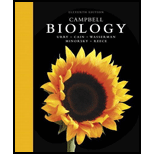
Concept explainers
Humans and chimpanzees are sister species. Explain what this Statement means.
To explain: How humans and chimpanzees are sister species.
Introduction: The genome of an organism contains stored information about genetic changes that have occurred over time. A phylogenetic tree can be constructed from the sequence of genes of different organisms. Evolutionary history can be deduced from the branching pattern of a phylogenetic tree. The branching pattern indicates the relatedness among the organisms. The group that shares the immediate common ancestors are called sister species.
Explanation of Solution
Chimpanzees and humans are hominoids. They are together classified under the suborder: Anthropoidea. They branched off from a common ancestor. Chimpanzees and humans are the modern-day descendants of their lineage. Their lineage shows that they diverged 4 million years ago, but chimpanzees and humans did not exist at that time. Some undiscovered ancestors existed around 4 million years ago and it was a hominoid. It was neither a chimpanzee nor a human. It would have had a human-like and chimpanzee-like ancestor. Closely-related organisms resemble one another due to their common ancestry. However, it is not always possible if their lineage has evolved at different rates or has faced different circumstances. Phylogenetic analysis is helpful to infer the identity of species by analyzing the relatedness of DNA sequences. Humans and chimpanzees being sister species indicate that they both share an immediate common ancestor or that they have descendants from a common ancestor. Both the organisms are closely related to each other more than any other organisms.
Want to see more full solutions like this?
Chapter 26 Solutions
Campbell Biology (11th Edition)
- In one paragraph show how atoms and they're structure are related to the structure of dna and proteins. Talk about what atoms are. what they're made of, why chemical bonding is important to DNA?arrow_forwardWhat are the structure and properties of atoms and chemical bonds (especially how they relate to DNA and proteins).arrow_forwardThe Sentinel Cell: Nature’s Answer to Cancer?arrow_forward
- Molecular Biology Question You are working to characterize a novel protein in mice. Analysis shows that high levels of the primary transcript that codes for this protein are found in tissue from the brain, muscle, liver, and pancreas. However, an antibody that recognizes the C-terminal portion of the protein indicates that the protein is present in brain, muscle, and liver, but not in the pancreas. What is the most likely explanation for this result?arrow_forwardMolecular Biology Explain/discuss how “slow stop” and “quick/fast stop” mutants wereused to identify different protein involved in DNA replication in E. coli.arrow_forwardMolecular Biology Question A gene that codes for a protein was removed from a eukaryotic cell and inserted into a prokaryotic cell. Although the gene was successfully transcribed and translated, it produced a different protein than it produced in the eukaryotic cell. What is the most likely explanation?arrow_forward
- Molecular Biology LIST three characteristics of origins of replicationarrow_forwardMolecular Biology Question Please help. Thank you For E coli DNA polymerase III, give the structure and function of the b-clamp sub-complex. Describe how the structure of this sub-complex is important for it’s function.arrow_forwardMolecular Biology LIST three characteristics of DNA Polymerasesarrow_forward
 Concepts of BiologyBiologyISBN:9781938168116Author:Samantha Fowler, Rebecca Roush, James WisePublisher:OpenStax College
Concepts of BiologyBiologyISBN:9781938168116Author:Samantha Fowler, Rebecca Roush, James WisePublisher:OpenStax College Biology Today and Tomorrow without Physiology (Mi...BiologyISBN:9781305117396Author:Cecie Starr, Christine Evers, Lisa StarrPublisher:Cengage Learning
Biology Today and Tomorrow without Physiology (Mi...BiologyISBN:9781305117396Author:Cecie Starr, Christine Evers, Lisa StarrPublisher:Cengage Learning Biology (MindTap Course List)BiologyISBN:9781337392938Author:Eldra Solomon, Charles Martin, Diana W. Martin, Linda R. BergPublisher:Cengage Learning
Biology (MindTap Course List)BiologyISBN:9781337392938Author:Eldra Solomon, Charles Martin, Diana W. Martin, Linda R. BergPublisher:Cengage Learning Biology: The Unity and Diversity of Life (MindTap...BiologyISBN:9781305073951Author:Cecie Starr, Ralph Taggart, Christine Evers, Lisa StarrPublisher:Cengage Learning
Biology: The Unity and Diversity of Life (MindTap...BiologyISBN:9781305073951Author:Cecie Starr, Ralph Taggart, Christine Evers, Lisa StarrPublisher:Cengage Learning Human Biology (MindTap Course List)BiologyISBN:9781305112100Author:Cecie Starr, Beverly McMillanPublisher:Cengage Learning
Human Biology (MindTap Course List)BiologyISBN:9781305112100Author:Cecie Starr, Beverly McMillanPublisher:Cengage Learning





